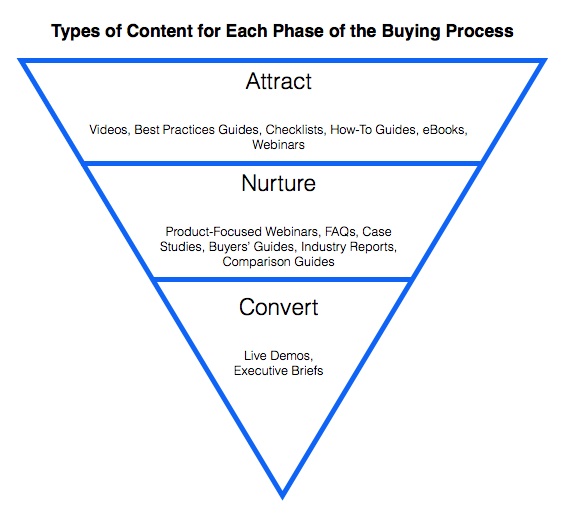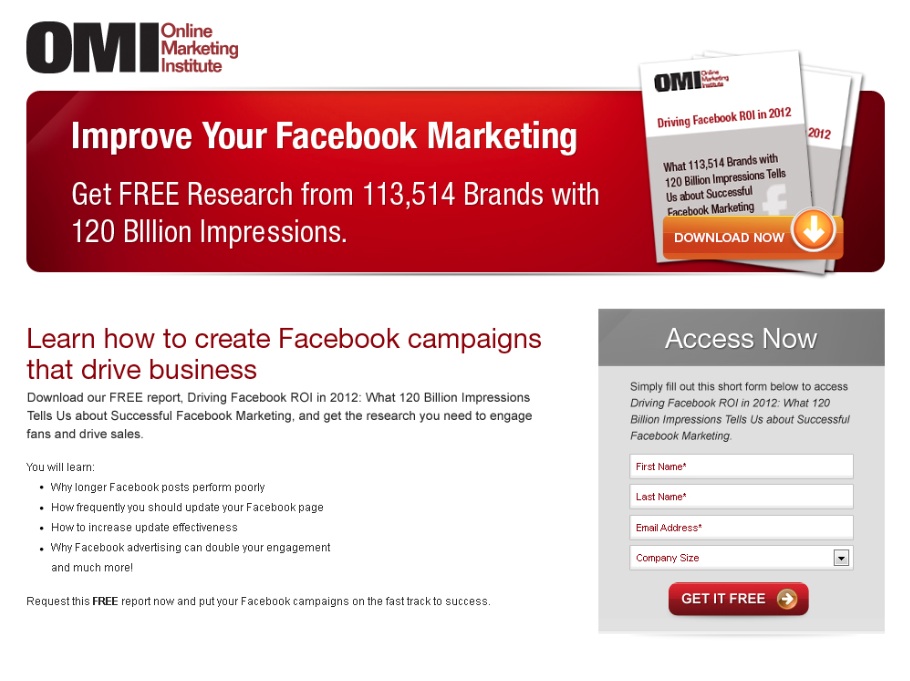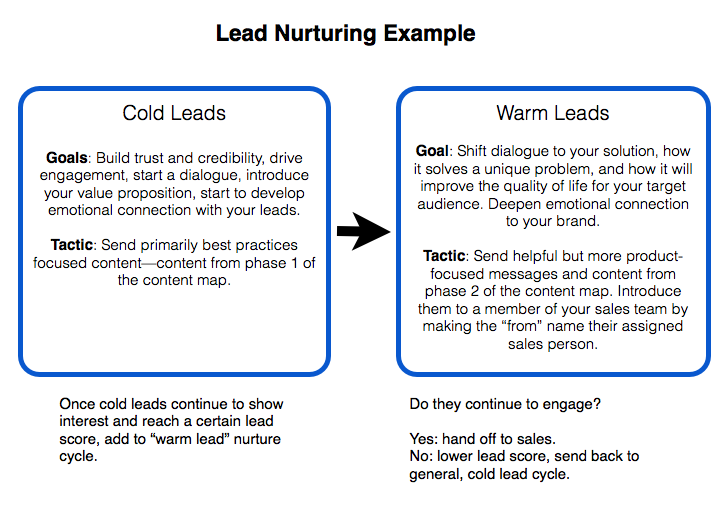 It's an exciting time to be a B2B marketer.
It's an exciting time to be a B2B marketer.
According the Corporate Executive Board, 60% of the B2B buying process now happens before a prospect ever talks to a salesperson. As marketers, we are more valuable than ever before. We are now tasked with:
- Attracting and engaging leads
- Addressing pain points
- Overcoming sales objections
- Providing solutions
This is an exciting opportunity for marketers to impact revenue, and with the right digital tools and strategies, we can make it happen.
With that in mind, I've outlined what I think are the 3 biggest opportunities for driving revenue in B2B digital marketing, and how you can improve each initiative in 2013.
When you focus on improving these key programs—content, conversion optimization, and lead nurturing—you will be better equipped to improve your search, social, mobile, and digital advertising results, as well. An integrated digital marketing strategy and plan is key.
1. Develop Content for Each Stage of the Sales Cycle
Create a framework for matching your prospects' needs with captivating content to navigate through the complexities of the marketing funnel, and drive action on the part of your target audiences. This content framework should be integrated into your entire digital strategy—content, including blogs, white papers, eBooks, and more, is the fuel for your search, social, lead nurturing, and digital marketing programs.
Your content should:
- Provide solutions to improve your target audience’s day-to-day work environment, business results, and quality of life
- Be helpful and of value to your target audience
- Build trust and credibility in your brand
- Help your target audience develop an emotional connection to your brand
- Build the case for your solution
As part of your 2013 content strategy, focus on crafting content for your most important and profitable segment. These are the customers you know and understand well, and the ones that can have the biggest and most immediate impact on your bottom line.
Break the content you create into three phases: cold (attract), warm (nurture), and hot (convert). While the graphic below can serve as a guide in your content development, content marketing is not black and white—there is overlap. What's important is that the most relevant content is available to your audience at the right time, whether they find it themselves on your website, or receive it via your lead nurturing program.
Phase 1: Attract
Start by creating content that is directly related to the problem your solution solves. This content should attract and engage the type of lead that already has a need for your solution. Consider this your low hanging fruit—the potential buyers most likely to close. For example, if you offer a marketing automation solution, your phase 1 content should include best practices for lead nurturing, lead scoring, email segmentation, email frequency, reducing the sales cycle etc.
Once you have that down, cast a wider net by developing content that is valuable to your best, most profitable customers, but not necessarily directly related to your product or service. This is especially helpful if you market a disruptive product—a new innovation that your target audience doesn't have a line item for, or a clear understanding of just yet. Then, you can nurture the lead over time, and start to build the case for your solution, before the lead has even pinpointed a problem. Once the lead identifies their need and enters the consideration phase, they will already have developed trust and a connection to your brand, and your company will be top of mind, instead of your competitors.
For example, Marketo and Eloqua not only create content about lead nurturing best practices, but they also do a great job creating content about other aspects of B2B marketing and sales. They cover content marketing, B2B social media, search etc., even though their main offering is marketing automation.
TIP: For any content that isn't behind a lead capture form, such as your blog, make sure to include an easy and obvious way for visitors to opt-in to your lead nurture program. If you look at the HubSpot blog, they include various conversion points, such as banners within blog entries, and a subscribe form on the right rail.
Phase 2: Nurture
Once you’ve attracted the lead and they begin to get to know your brand, your content should help build the case for your solution. At this point, it’s likely that these prospects still haven’t spoken with a salesperson, but as part of your lead nurturing program, your content can begin to move the prospect down the funnel with more product-focused webinars, 3rd party reports, etc.
Help your prospects overcome any initial sales objections through FAQs, case studies, ROI calculators or even blog posts. For example, a common sales objection is “I have no budget.” You can explain to your prospects how to get their budget approved, or how to find budget (there usually is one!) during a webinar, in a blog post, or as part of a buyer’s guide. You can also provide a simple calculator that demonstrates how your solution will ultimately help save money and improve profitability.
Even if your prospects aren’t currently engaged in a dialogue with a member of your sales team, that doesn’t mean they aren’t engaged in the buying process. Today’s B2B buyers have changed—they are laying low and taking matters into their own hands. With the technology and digital channels available today, messages traditionally communicated by salespeople can now quickly and consistently be delivered throughout the sales process via your integrated content marketing and lead nurturing program.
Phase 3: Convert
As sales starts to take over and get involved, your content marketing efforts can still help move the sales process along. Whether delivered by a sales team member, available on your website, or promoted via a drip campaign, content such as executive briefs, ROI calculators, and case studies can help seal the deal.
Create (or Repurpose) Content for Your Different Segments
Now, once you’ve developed content for the key stages of the buying cycle for your general audience or most important segment, identify your next important segment, and get more specific. Marketo has done a great job with this by developing specific blogs for both marketers (modern B2B marketing) and salespeople (modern B2B sales).
For example, if you market to both SMBs and the Enterprise, you can create two versions of your most popular white paper—one that addresses SMB pain points and solutions, and another that focuses on the unique challenges in the Enterprise. You don’t have to reinvent the wheel, either. You may very well be able to take one piece of content, update it, and repurpose it for each of your unique audiences. Assuming you have key segmentation data on your leads, you'll then be able to deliver the targeted content with your marketing automation solution.
2. Generate More Leads with High-Performance Landing Pages
You can't nurture what you don't convert.
According to a survey by BtoB Magazine, 59% of B2B marketers say email is the most effective channel for generating revenue. However, more than 60% of B2B marketers report that their greatest marketing challenge for 2012 was generating more leads. To efficiently boost revenue in 2013, focus on generating more leads by improving your landing pages, and then nurturing them to sale with a targeted lead nurturing program (more on that below).
I've created and tested many B2B landing pages—and I can you the absolute #1 most important element of your landing page is the message. Your headline and body copy must be clear, not clever, and focus on benefits, not features. I know you love your product (hey, I do too!), but strip your page of copy that focuses on features or company jargon. Instead, use the jargon that your target audience uses, and speak directly to them.
In this example below from one of our own campaigns, the headline and copy focus on clear and obvious benefits, and the page converts at over 60%.
Also, ensure that the message on your landing page clearly matches the message of the ad or offer that got the visitor to click. The more tightly matched they are, the higher your conversion rate will be. If you're managing a large scale or more sophisticated digital program, this means creating tens, if not hundreds, of unique landing pages. A landing page management solution such as LiveBall by ion interactive can help you scale your program efficiently.
Now that you've got the message down, the best way to see a continuous improvement in your conversion rate and lead quantity is to A/B test your landing pages. If you're not testing your pages already, it's always best to begin by testing the element that you think will have the biggest influence on conversions.
My favorite elements to test and constantly improve are:
- Required form fields: The less form fields you require on your landing pages, the higher your conversion rate will be. If the objective of you landing page is to generate leads for lead nurturing, I recommend only collecting first name, last name, and email address. You can gather more information on the leads over time with progressive profiling. Now, if your sales team or other members of the marketing team are hesitant to remove other fields, propose to A/B test the page. Once you can demonstrate the significant increase in lead quantity (and maybe even quality, because your best leads may be hesitant to share information), they'll agree to collecting less information initially.
- The headline: David Ogilvy once said, “On average, five times as many people read the headlines as read the body copy. When you have written your headline, you have spent eighty cents out of your dollar.” In my experience, simply testing your headline can result in a conversion increase of 100%.
- The call-to-action: Along with the overall message, your call-to-action is critical to the success of your landing page. The more specific the call-to-action, the better. Clearly state the intended goal of the page, and guide the visitor to complete the action that you want them to do.
- Design: Your design should enhance the message and support the goal of your page, not detract from it. A pretty page with a lousy message is far less effective than a boring page with a great message. But the real gold is when you combine a great message with an effective design. And the best way to find out which design supports your goal best is through testing. Start with high-contrast A/B tests, find champions, and go from there.
If you're ready to start testing, tools like Optimizely and Visual Website Optimizer allow you to easily test elements on your website, without working with IT or development resources. If the process of creating and managing landing pages is not a pain point for you, I recommend starting there. Most of the popular marketing automation solutions also include landing page testing capabilities. I find that what they really excel at, however, is lead management, scoring, and drip marketing–not landing page optimization.
If you're creating and testing multiple pages, solutions such as Unbounce (SMB) and LiveBall (Enterprise) make the conversion optimization process much more efficient by allowing you to create, test, and measure pages within a single platform—which results in faster speed-to-market, better performing campaigns, and higher revenue.
3. Nurture Leads to Revenue with Marketing Automation
Conventional marketing wisdom says it takes at least 7 touches to move a cold lead to become a customer. Instead of sending rapid-fire emails to your entire list, get more relevant by communicating to your leads based on their segment, place in the sales cycle (lead score), and actions they take on your site. Marketing automation solutions such as Pardot, Marketo, Eloqua, Manticore etc, allow you to score leads and deploy very targeted drip and email campaigns.
Having setup marketing automation solutions myself, I understand that it is a big task—from integration, to lead scoring, to strategy development etc. Depending on the size of your business and resources, the initial setup can take weeks, but the ROI is absolutely there. According to The Annuitas Group, businesses that use marketing automation to nurture prospects experience a 451% increase in qualified leads.
So once you have your marketing automation solution such in place, I recommend that you start small, and focus on your warmest leads.
Tips For Starting Your First Drip Campaign
- Focus on your warmest leads—the leads most likely to close: If you are already sending general, best practice-focused content to your leads every week or so (many B2B marketers I talk to are), your first drip campaign can focus on nurturing warmer leads, as these leads are your priority, and most likely to have an immediate impact on revenue.
- Determine which leads are already warm: Check your CRM, marketing automation, or email solution, and look up the names of some recent qualified prospects and customers. Take a look at how many times they visited your website and opened emails, which pages on your site they visited etc. It’s going to be different for everyone—but this is a good starting point for deciding how to score your leads, and determine which ones are into you, and which ones aren’t… just yet. It's always a good idea to work directly with sales on this, as well.
- Flag your warm leads: Once you have a good idea of which leads are warm, you'll be able to add them to this “warm lead” nurture cycle. This is usually a pretty simple process. For example, within the marketing automation solutions I have used, you can setup a rule that says, "if lead score is above 50, add to XYZ campaign".
- Develop your email messages: Your 5-part campaign should shift the dialogue from best practices to your solution, and how it solves a unique problem that your target audience has. Focus on benefits, and introduce prospects to your sales team by making the from name of your messages a sales team member. You can even include a headshot of a sales team member in the email signature. I've had great success with both text-based and HTML emails. Overall, simple works, and what's most important is that your message is relevant and meaningful. Your email design should support, and not detract, from that message.
- Decide on frequency: As a general rule, I find that spacing out your emails every 7 days is a good place to start. Monitor open rates and click-thru rates to see how your leads are responding. Once your program gets more sophisticated, you can provide frequency options, and increase the frequency based on response rates or actions that your leads take. For example, if a lead visits a page on your site that explains technical requirements, but does not take any other action, you can trigger an email within 24 hours that invites them to attend a demo etc.
Overall, your goal is develop an emotional connection with your prospects, and communicate how your solution will improve their day-to-day working environment, professional aspirations, and success in business and beyond.
Lead nurturing programs can become very sophisticated, but again, if you’re just starting out, start small, and go from there. The below example is a good, general place to start—a simple program that focuses on nurturing your warmer leads, so they can be handed off to sales for follow up.
Bonus Tip! Attract and Engage with Visual Storytelling
Once you have a defined content program in place, visual content can really help amplify your efforts. Over the past year or so, visual storytelling has become one of the hottest ways to tell your brand's story. And with good reason—it works.
Visual content, including memes, presentations, videos, infographics and photos, is easily shared through social channels. Adding visual content to your digital marketing mix allows you to deliver your message to your audience—without requiring them to invest time in reading.
According to 3M Corporation, 90% of information transmitted to the brain is visual, and visuals are processed 60,000X faster in the brain than text. Publishers that use infographics grow traffic an average of 12% more than those who don't (source: Ansonalex).
If you're not already using visual content, determine if it will help you achieve your marketing objectives. Start small by promoting an infographic on your blog, or sharing a relevant meme on your Facebook page. Review the results, and go from there.
Here's to a successful 2013!
Take the Next Step to More Leads and Higher Revenue
To dive deep into B2B digital marketing, explore the Online Marketing Institute's collection of B2B-focused online classes, including a few of my favorites:
Content Is Opportunity: Developing Content for Every Stage in the Buying Cycle with Michael Pranikoff
B2B Visual Storytelling Best Practices with Lisa Buyer
Landing Pages for Business Marketing with Scott Brinker
How to Develop a Lead Management Process and Plan with Carlos Hidalgo


